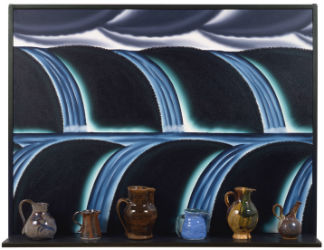
NEW YORK – The Museum of Arts and Design (MAD) presents an exhibition dedicated to the work of American artist Roger Brown (1941-1997), examining the ways in which collecting, arrangement and the theatrical informed and enriched his artistic practice. “Roger Brown: Virtual Still Lifes,” on view through Sept. 15, features works made in the final years of the artist’s life that combined his passion for collecting with his groundbreaking approach to painting. Marking the first solo museum show in New York devoted to Brown, the exhibition at MAD offers a rare opportunity to view over 40 works that trace the artist’s evolution through the lens of collection and display.
Brown is associated with the Chicago Imagists, an informal affiliation of representational artists that emerged from the School of the Art Institute of Chicago in the post-World War II era. Brown and his contemporaries – Ed Paschke, Barbara Rossi, and Phil Hanson, among them – drew from references outside of the fine art canon, including commercial art, comics, surrealism, self-taught art, and popular culture, to develop an aesthetic sensibility uniquely their own. Brown’s work is included in nearly 100 public collections across the nation.
“Roger Brown is a historically significant figure in American painting,” said Shannon R. Stratton, exhibition curator and former MAD chief curator, “whose signature style of ominous weather, patterned landscapes, omnipotent points of view, and nods to the theatrical make for a nuanced critique of the artificiality of postwar American culture. His and his contemporaries’ influence can be felt anew, as young artists today re-explore surrealism, pop culture and vernacular aesthetics as a means to examine contemporary life.”
Brown’s “Virtual Still Life” series became a studio expression of his collecting and curating of found objects. To create the 27 works in the series, eight of which are on view at MAD, Brown selected from nearly 500 objects, primarily ceramics, and curated distinct arrangements on display shelves extending from beneath his painted canvases of stylized landscapes.
Frothy waterfalls flow into an array of pitchers in Virtual Still Life #15 Waterfalls and Pitchers (1995); mugs arranged by height mirror the rugged mountain range of Virtual Still Life #11 Mugs and Mountains (1995); and a harmony of color blends seamlessly from canvas to a singular pot in Virtual Still Life #5 Elegant Pot with Gold Sky (1995).
“Brown did not believe in the artificial hierarchies imposed on human creativity,” Stratton said, “and his eventual integration of his collecting practice with his canvases was an intentional leveling of those hierarchies, literally foregrounding the work of unknown potters and other makers.”
Organized into five sections, the exhibition positions the “Virtual Still Life” paintings alongside earlier works from various stages of Brown’s career, illuminating his process and tracing the development of his last important series.
A grouping of carved wood hearse panels from Brown’s personal collection, which mimic the dramatic folds and sweeping drapes of the curtains that flank theater stages and movie house screens, introduce the artist’s “Theater Paintings.” The works in this section, part of a series of more than 20, depict interior theater scenes, many framed by architectural curtains, and reflect the artist’s interest in the stage and concepts of spectacle or display from early in his career.
“Painted Objects” features a range of painted, found furniture and sculpture by Brown, including chairs, stools and a footboard. One of the earliest works in this section, Untitled (Crawling, Flagellated Building) of 1975, foreshadows Brown’s virtual still lifes through the placement of his crawling Christ as a skyscraper on a shelf in front of a stylized sky.
The large projected images of Home(s), give a glimpse into the live-work spaces Brown inhabited in Chicago, Illinois, New Buffalo, Michigan, and La Conchita, California, and the collections specific to each site. The photographs illustrate how Brown curated and displayed the collected objects – ranging from toys and ephemera from popular culture and advertising to indigenous, folk, craft, and self-taught art – that surrounded him.
Upon his death in 1997, two of Brown’s homes and their collections were gifted to his alma mater, the School of the Art Institute of Chicago, and would come to form the basis for the school’s Roger Brown Study Collection.
“Ceramics” features two of 10 preserved arrangements of pottery and ceramics from Brown’s home in La Conchita, where he collected works of amateur and anonymous studio pottery, mid-century California wares, and regional and folk craft pottery from Mexico. The Untitled Arrangement (Studio Left Unpainted) consists of a humble wood cupboard, its shelves practically brimming over with meticulously arranged bowls, vessels and platters in a variety of shapes, sizes, colors and finishes.
Additionally, the Museum of Arts and Design will host a two-day symposium focused on the artist’s work and career on Sept. 7–8. Coinciding with the release of the limited-edition book, Roger Brown: Virtual Still Lifes edited by Stratton and published in collaboration with the School of the Art Institute of Chicago, the symposium will include film screenings, lectures and tours of the exhibition. More information and registration information will be available at madmuseum.org in the coming months.
The exhibition and its accompanying publication are produced in partnership with the School of the Art Institute of Chicago.


